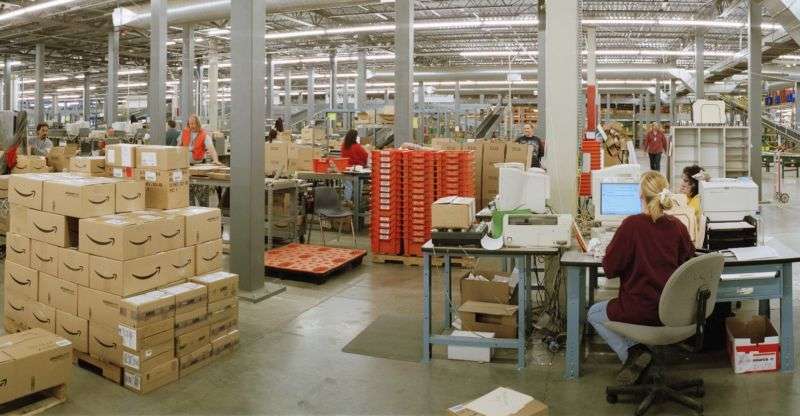
Amazon made video games for its workers to reduce tedium of warehouse jobs

Amazon has created video games that its warehouse workers can “play” while they fill customer orders in an effort to speed up fulfillment and relieve the tedium of packing products into boxes.
The Washington Post described the warehouse games in a report yesterday:
Developed by Amazon, the games are displayed on small screens at employees’ workstations. As robots wheel giant shelves up to each workstation, lights or screens indicate which item the worker needs to pluck to put into a bin. The games simultaneously register the completion of the task, which is tracked by scanning devices, and can pit individuals, teams or entire floors against one another to be fastest, simply by picking or stowing real Lego sets, cellphone cases or dish soap. Game-playing employees are rewarded with points, virtual badges and other goodies throughout a shift.
Think Tetris, but with real boxes.
Amazon has deployed the games in “five warehouses from suburban Seattle to near Manchester in Britain, after starting to offer them at a lone warehouse in late 2017,” the Post wrote. The games ratchet up workplace competition, while “slyly pushing workers to raise the stakes among themselves to pack more boxes bound for customer homes,” the Post wrote. (The Washington Post is owned by Amazon founder and CEO Jeff Bezos.)
Playing the games is voluntary. No images of the games were revealed, but the Post said the games have names such as “MissionRacer, PicksInSpace, Dragon Duel, and CastleCrafter” and “have simple graphics akin to early Nintendo games like Super Mario Bros.” Workers described the games to the Post on condition of anonymity.
The use of robots in Amazon warehouses the past few years has reduced the amount of walking employees do, as workers spend more time in front of computers while “wheeled robots bring stocked shelves to them,” the Post wrote. With robots making it easier for employees to grab products from shelves, workers say that Amazon raised requirements “from picking 100 items an hour off shelves to 300 items per hour and later nearly 400 per hour,” the article said.
“One worker said she had at times picked nearly 500 items off the roving shelves in one hour, egged on by the game pitting her against other pickers to compel a racecar around a track,” the Post wrote. “She said pickers and stowers compete with one another to complete video game tasks faster, meaning they are moving more real merchandise onto trucks that bring them to customers’ doorsteps.”
When contacted by Ars today, Amazon confirmed that it is piloting the games in five of its fulfillment centers and provided a few other details. Amazon told us that it has no plans to make the games mandatory and that workers who opt into the games can switch back to non-game work methods any time they want.
Amazon said it is trying to create a more fun and interactive work environment and that workers can play the games in an anonymous mode if they prefer not to show their name to others playing the games or on leaderboards.
Workers under pressure
Amazon didn’t tell us whether the games have had any measurable impact on productivity. The company said that some users choose to never play the games, while others play some of the time, and some people play for the entire time they are at work.
Various news articles and lawsuits have detailed grueling working conditions at Amazon warehouses. For example, at least seven lawsuits over the last eight years were filed against Amazon by women who say they were fired after Amazon refused to accommodate their needs during pregnancy. While Amazon has automated parts of the fulfillment process, it still needs human workers.
“The company said it doesn’t monitor game results or penalize workers for not participating,” the Post article said. “However, warehouse workers are tracked carefully for speed, efficiency and other factors, and those who underperform can be fired or reassigned. And if the games are helping to push workers to be more productive, it could make those who eschew them appear to be straggling.”
Gamification can have both positive and negative impacts on workers, according to experts quoted by the Post. Gabe Zichermann, a book author and consultant who specializes in gamification, told the Post that gamification “is most successful when the games are replacing tasks that are otherwise boring” and can increase worker happiness by reducing drudgery.
“But, he said, gamification can be used to mask higher productivity goals, because the games’ algorithm is typically kept secret,” the Post continued. “In customer service jobs, for instance, gold stars awarded for resolving 20 customer concerns may over time require 22 or 25. ‘When [employers] want to generate more output, they can ratchet those levers,’ [Zichermann] said. ‘It’s like boiling a frog. It may be imperceptible to the user.'”
Video game designer Jane McGonigal has also studied workplace gamification and told the Post that “Competition is only enjoyable for a short time… As soon as workers start underperforming against their colleagues, it becomes less fun and can actually be counterproductive.”




